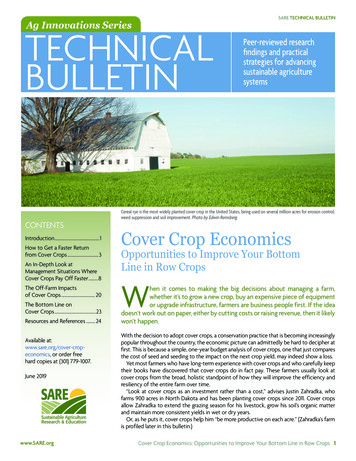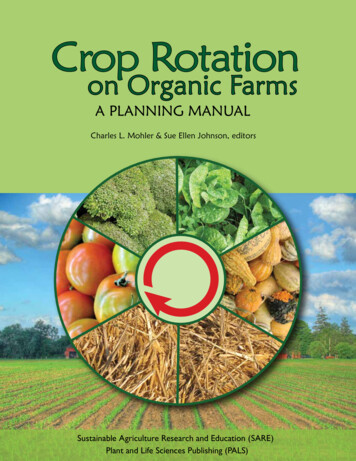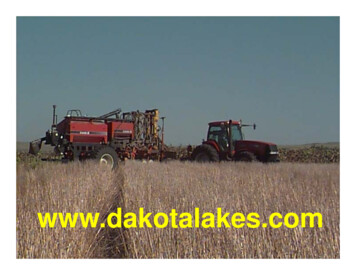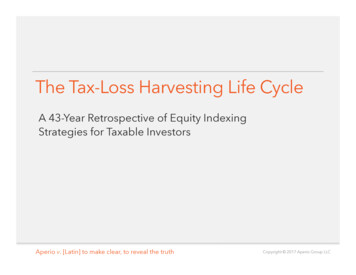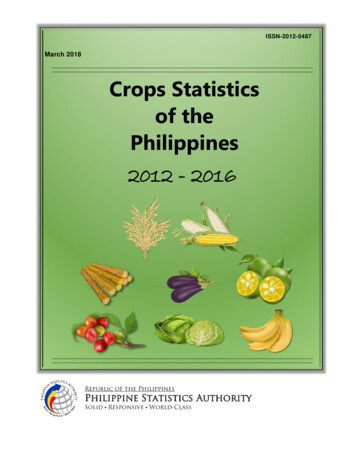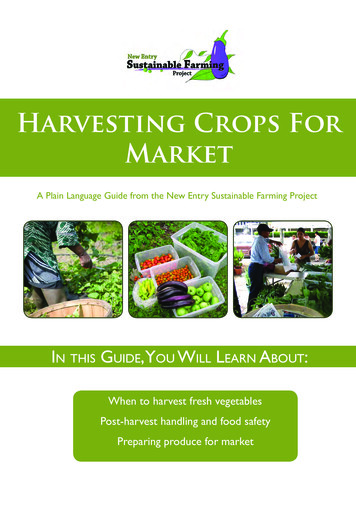
Transcription
Harvesting Crops ForMarketA Plain Language Guide from the New Entry Sustainable Farming ProjectIn this Guide,You Will Learn About:When to harvest fresh vegetablesPost-harvest handling and food safetyPreparing produce for market
New Entry Sustainable Farming Projectin Collaboration with World PEAS CooperativeAuthored by Vanessa BittermanReviewed by Jennifer Hashley, New Entry Sustainable Farming Project DirectorGraphic Design by Zoe Harriswww.New Entry Sustainable Farming Project.orgMay 2007Boston Office:New Entry Sustainable Farming ProjectTufts UniversityGerald J. and Dorothy R. Friedman School of Nutrition and Sciency PolicyAgriculture, Food and Environment Program150 Harrison StreetBoston, MA 02111(617) 636-3793Lowell Office:New Entry Sustainable Farming Project9 Central Street, Suite 402Lowell, MA 01852(978) 654-6745For additional information regarding this document, please email: nesfp@tufts.edu, orcall (978) 654-6745. This document is available in electronic format or as a printed copy.The latter may be obtained by contacting New Entry Sustainable Farming Project at theabove locations. Please contact New Entry for permission to use any part of this document for educational purposes.Production of this document was supported by the SARE Professional Development Grant ENE05-092, USDACSREES 2501 Program, and by USDA Risk Management Agency (RMA Partnership Agreement No. 06IE08310159).“In accordance with Federal law and US Department of Agriculture policy, this institution is prohibited from discriminatingon the basis of race, color, national origin, sex, age, or disability. To file a complaint of discrimination, write USDA, Director,Office of Civil Rights, Room 326-W, Whitten Building, 1400 Independence Ave SW, Washington, DC 20250-9410.Or call (202) 720-5964. USDA is an equal opportunity employer.”
Purpose of this GuideWho should read this guide?This guide is written for people who want to learn about produce handling that takesplace after harvest. If you would like to improve the look and feel of your produce atthe market, it is a good idea to read through this guide. By investing time in properlyhandling vegetables in the field and during packing, you will be rewarded by better salesof your products.You will benefit from this guide if you: Have never farmed before and wish to learn how to obtain the best outcome foryour harvest.Have been gardening for a long time and want to expand and sell your crops tomake money.Have sold your crops at farmers markets, restaurants and wholesale outlets, but wishto sell produce that looks better and lasts longer. That is, produce that has a greater‘shelf life.’Need to know how to bunch and weigh specific crops.Would like to learn food safety tips to keep your customers healthy when eatingyour products.It may be helpful for you to use this workbook with someone who can guide you tomore farming information, such as an experienced farmer, staff member of a farm serviceorganization, or other service provider.What is Plain Language?This guide is presented in a format called Plain Language. Plain Language provides clear,simple, and accessible text for readers in order to reduce misunderstandings, errors, andlack of comprehension. It also helps guide you through action steps to practice whatyou learn, and gives examples of other people using the information. We present thisguide in Plain Language in order to make the topic accessible to everyone.Harvesting Crops For Market
Harvesting Crops For Market
ContentsIntroduction.2Food Safety Overview.3Greens.4A Note on Bunch Sizes.7Fruit and Melons.8Storing Fruit and Melon Crops.10Onion Crops.11Cruciferous Vegetables.13Roots and Tubers.15Beans and Peas.17Herbs.18Pumpkin and Squash Blossoms.19Pumpkin and Winter Squash.20Bunch Size Guide.21Resources.22Harvesting Crops For Market1
IntroductionAs a farmer, you want the vegetables you grow to be fresh and high-quality.You also want to harvest them at the proper time, knowing how to beefficient with your time and how to handle each kind of vegetable properly.Your customers may not know exactly when and how you harvested yourproduce, but they will be able to see and appreciate clean, fresh vegetables!This Guide can help you make sure your produce gets to your customers atthe right time, in the right amounts, and at top quality.The keys to harvesting produce are: Picking vegetables when they reach the right size.Picking vegetables at the right time of day.Handling the vegetables as little as possible.Bunching or packaging the vegetables in recommended sizes and quantities.Selecting the right package or container to store vegetables.Storing the vegetables properly and at the right temperature.Remember, you can spend months and months growing a crop, but if it is not clean, fresh,and beautiful when it gets to market, customers will not buy it! So it is important toharvest, handle, and store your vegetables properly. Take the extra time at first to learnabout harvest and post-harvest handling. Soon you will be faster, more efficient, andyour customers will keep coming back!2Harvesting Crops For Market
Harvesting tips by crop type:This guide is organized by crop type and will invlude general information on: When to harvest Best time of day to harvest Harvest and post harvest handling instructions Bunch or unit sizes Storage suggestions Tips and tricks for packaging and keeping produce freshHarvesting Crops For Market3
Food Safety overviewThe majority of farm fresh foods are wholesome and safe to eat raw.However, as a farmer, it is necessary that you take steps to reduce the risk ofcontamination to protect your customers and your business. There are somekey practices you should follow to ensure the safety of your food and workers,called Good Agricultural Practices (GAP). Below are a sample of GAPpractices. Your farm can be ‘GAP Certified’ by an auditor. See the AppendixSoil Water Workers Chemicals Handling 4Know the history of the land. Have chemicals or manure beenapplied to the land in the past?Select fields that are uphill or are located far from animal housingand grazing areas to avoid contamination from animal manure oranimals’ walkin on or near crops.Use composted manure instead of fresh manure on fields whenpossible.Maximize the time between manure application and crop harvest.Document all manure applications to your fields.Be familiar with the source of your water. Where does it comefrom? Are there any operations upstream that may affect its quality?Be sure that your water wells are designed and maintainedproperly.Have your well water tested at least annually to be sure it is safeto drink and wash vegetables.Encourage workers to wear clean, protective clothing in the field.Provide toilet facilities to all workers in the field and in thepacking house.Require workers to wash hands with hot, soapy water after usingthe bathroom.Follow instructions when using pesticides. Alwasy follow days-toharvest instructions on the label.Store chemicals properly.Clean and rinse spray equipment to keep it in good workingcondition.Develop daily cleaning schedules for work surfaces, restrooms,and keep maintenance logs.Remove excess soil from produce in field.Protect produce from direct sun exposure.Wash harvest bins regularly to reduce sources of contamination.Keep pest from contaminating packaging materials.Harvesting Crops For Market
GreensAmaranthArugulaCollard GreensKaleLettuceMustard GreensPea TendrilsPumpkin VinesSalad MixSweet Potato GreensSwiss ChardTat SoiWater SpinachWhen to Harvest/Maturity Guidelines: Harvest before the plant flowers or sends up a flower spike.Leaves should be tender, not tough.For arugula and salad mix, cut when leaves are small and very tender (3-4 incheshigh); be sure weeds or grasses have been removed from harvest area.For pea tendrils, snap off tips of plants where stem is still succulent and soft; harvestbefore stems turn stiff or woody.Time of Day to Harvest: Early morning is the best time to harvest most greens, since that is the coolest timeof day.If morning is not possible, try to harvest in the evening after the heat of the day haspassed.6:00am-9:00am OR 5:00pm-9:00pmHarvesting and Post-Harvest Handling Instructions: Dunk greens in cold water and keep moist in a shaded basket or bin while in thefield.Remove any weeds or grasses from the crops.To keep greens from wilting, they must be cooled as soon as possible after harvestDiscard any bruised, torn or otherwise damaged leaves.Harvesting Crops For Market5
Tie the following greens in bunches:CropBunch SizeAmaranthCilantroCollard GreensFenugreek LeavesJute Greens0.5 lbs0.2 - 0.25 lbs0.5 lbs0.5 lbs0.5 lbs0.5 lbs0.5 lbs0.5 lbs0.5 lbs0.5 lbs0.5 lbsKaleMustard GreensPumpkin VinesSweet Potato GreensSwiss ChardWater SpinachBunched GreensTip: Use rubber bands or twist ties to hold the greens together in bunches.Trim the ends to even them out if necessary.The following greens should be bagged:CropBag WeightArugulaLettuce0.3 - 0.5 lbs1 large head or 2-4small heads per bag0.2-0.3 lbs0.3-0.5 lbsPea TendrilsSalad MixBagged GreensTips: 6Be careful not to bag greens without removing ‘field heat’ or coolingfirst!If greens do not cool first, they may ‘sweat’ or wilt in the bag.Allow adequate air space in the bag and either leave open or closeloosely if on display at a market.Keep bagged greens out of sunlight.Harvesting Crops For Market
Greens Must Be:1. Picked2. Washed3. Bunched or Baggedand Weighed4. Stored in coveredboxes in the shade or ina coolerTips:Greens will droop and wilt (lose their moisture) very quickly if they are leftout in the sun. Keep greens moist and cool at all times. When you first put a tote of greens in the cooler, leave the top flap openso the greens can release the heat from the field. Do not seal bags of greens. Let air flow in so the greens can cool off. Mist or sprinkle water over loose greens to keep them wet.Harvesting Crops For Market7
A Note on Bunch Sizes:Many people from Asia, Africa, and other countries use large amounts of greens whenthey cook. They want to see BIG bunches at the market. Most Americans do not use asmany greens in their cooking. They usually like SMALLER bunches.When you harvest and bunch your greens, think about where you will sell them. Willyou go to a flea market or farmers market where many people from different countrieswill be shopping? You might make your bunches a little bit larger to attract morecustomers.If you are selling the greens through World Peas Co-op or CSA, make smaller bunchesaccording to the guidelines given in this book. Most bunches of large leafy greens shouldweigh about 0.75 pounds. Smaller baby greens that you put in bags should only weighbetween 0.3-0.5 pounds.Remember, the smaller your bunches, the more bunches you will have, and the moremoney you can make. For example:Large BunchesBunch size 0.5 lbs6 lbs / 0.5 lbs 12 Bunches6 lbs ofPea TendrilsHarvestedx 3.00/bunch 36.00x 3.00/bunch 60.00Small BunchesBunch size 0.3 lbs6 lbs / 0.3 lbs 20 BunchesLook around at the market to see how big the bunches are at other tables. Experimentfor a couple of weeks to figure out the best bunch size that satisfies your customers andmakes you the most money. After that, be consistent each week so your customers willknow what to expect.Tips: 8Consider your customers’ demographics when deciding how big tobunch your greens.Scout your competition, but be sure you can make money with your sizeof bags or bunches.Be consistent with bunch or bag sizes each week so your customers willknow what to expect and stay loyal to you.Harvesting Crops For Market
Fruit and MelonsAsian CucumbersBitter MelonCucumbersEggplant, all varietiesKittelyPeppers, all varietiesSummer SquashTomatillosTomatoesZucchiniWhen to Harvest/Maturity Guidelines: Harvest when fruit is the desirable size and/or color, and when the flesh is firm butripe.For cucumbers, eggplant, melon, and squash, do not harvest too late, or fruit canbecome bitter and/or seedy.Time of Day to Harvest: Early morning is the best time to harvest, while it is still cool but after dew has driedfrom the fruit.7:00am-9:00amHarvesting and Post-Harvest Handling Instructions: Cucumbers, melons, and tomatoes can be picked by turning the fruit parallel to thestem and quickly snipping it off.Use scissors or clippers to cut the stems of eggplant, peppers, and squash just abovethe fruit.Keep fingernails trimmed when harvesting squash to avoid punctures.These crops are delicate - be careful not to puncture or bruise during harvest.Do not stack too many fruits in one bin or those at the bottom will be crushed.Keep vegetables in the shade and cool as soon as possible.No need to rinse or wash unless dirt has adhered to the vegetables.Harvesting Crops For Market9
Do NOT put cherry tomatoes, or other fruits that bruise easily, into a large tote.The ones at the bottom will be crushed by the weight of those on top, and will be ruined.Instead, put cherry tomatoes or other fruits into pint containers right away.This will save you time, and prevent them from being crushed.Tip: 10A bread tray is a helpful way to carry stacked pints of produce.Harvesting Crops For Market
Storing Fruit and Melon CropsFruit crops including tomatoes, cherry tomatoes, eggplant, and tomatillos should not berefrigerated below 50 F. They can be damaged if they get too cold, so do not put theminside the same cooler you use to chill greens. Instead, store them outside in the shade,under trees or in a cool spot out of the rain.Other crops, including bitter melon, cucumbers, peppers, and squash, should be cooledand refrigerated. Place them gently in boxes or totes, then keep them in the shade untilthey can be put in the cooler.Tips:Many fruit and melon crops are very delicate, but they can also be veryheavy. Trim your fingernails to make sure you don’t accidentally puncturesquash, tomatoes, or eggplant while you are picking them. When in the field, move your basket or bin every few feet as you movedown the row so you can gently place the fruits inside, rather thantossing them. This will prevent bruising. Pick your tomatoes directly into baskets if that is how you plan todisplay them at market, to avoid handling twice. This also saves time andprevents bruising. Harvest zucchini or summer squash daily or every other day to keep upwith new ones that mature or reach market size. Label each variety so you can educate your customers. Leave room in the basket or bin when you are harvesting the vegetables.Do not fill it too full or you could hurt your back when carrying it offthe field and bruise the fruits or veggies along the bottom and sides ofHarvesting Crops For Market11
Onion CropsGarlic ChivesGreen OnionsShallotsBulb OnionsGarlicWhen to Harvest/Maturity Guidelines: Harvest garlic chives when they are 10-12 inches tall. They may be harvested beforeor during flowering.Harvest green onions when they are about 18-24 inches tall and when their stemsare about as wide as a pencil or slightly larger.Harvest shallots in the fall, when the tops turn brown and fall over and the bulbs are1-2 inches wide.Harvest onions in the fall, when the tops turn brown and fall over and the bulbs areat least 2 inches wide.Know the difference between fresh-eating onion varieties and storage onionvarieties.Harvest garlic in mid-summer when 2-3 leaves turn yellow and dry down.Harvesting and Post-Harvest Handling Instructions: 12Pull up green onions by hand. Trim roots and pull off any yellow leaves. Spray witha hose to wash off dirt. Use rubber bands to fasten into bunches. Keep in a moist,shaded bin while in the field, and put in a cooler as soon as possible to keep fresh.Use scissors or a sharp blade to cut garlic chives just above the ground. Tie intobunches using rubber bands. Dunk in cold water and put in cooler as soon aspossible to keep fresh.Pull up shallots, garlic, and onions by hand and place in single layers on screens ortrays. Let sit and ‘cure’ for a few days in a warm, dry, shady place. Trim off roots andstems. Garlic and shallots will keep for several months if cured and stored properly.Bulb onions should be harvested when their leaves are at least half dried andyellowed. The tops will have fallen over by this time. Harvest when the weatheris dry; the onions can develop diseases if they are pulled after a rainfall or in damp,humid weather.After harvesting, bulb onions and garlic bulbs must be cured. This means, they mustbe left to dry and the skins must harden.Curing can be done either outside in the sun, or in a greenhouse, as long astemperatures do not go above 85 degrees and onions and garlic are cured when theneck is completely dry and tight.After curing, trim necks to 2-3 inches above the bulb and store in a cool, shadylocation.Harvesting Crops For Market
Use rubber bands to tie the following crops into bunches:CropBunch SizeGarlic ChivesGreen Onions0.2 - 0.3 lbs0.2 - 0.3 lbsThis bunch is too big!Keep bunch sizes small.Tips: You may need two rubber bands to hold together green onion bunches.Fasten the first rubber band near the bottom of the bunch, then looselyfasten another rubber band near the top to hold the stems together, butdo not wrap it too tightly.If your green onions are very tall, you can trim the tops to an even heightto make the bunch look neater.Storage onions should be stored in a cool, dry, and ventilated place.Warmth and moisture will cause sprouting. Store cut onion in air tightcontainer in fridge and use quickly. If stored in a dry cool place (50 to 60degrees F), they will keep for months.Store garlic in an open container in a cool, dry place away from otherfoods. Do not refrigerate or freeze unpeeled garlic. Properly stored garliccan keep up to three months.Harvesting Crops For Market13
Cruciferous VegetablesBaby Bok ChoyBroccoliBroccoli RaabChinese BroccoliCabbagePac ChoyWhen to Harvest/Maturity Guidelines: Harvest baby bok choy or pac choy when the leaves are about 6-10 inches heigh.Cut just above the root so the head stays together.Broccoli should be harvested when the heads are fully formed but still tight andcompact - before flowering. If you leave the plant in the ground more baby broccoliheads will grow off the main stalk that you can keep harvesting.Broccoli raab and Chinese broccoli should be harvested when the leaves are stilltender and flower heads are formed. Chinese broccoli may be starting to flower attime of harvest.Pick cabbage when the heads are fully formed and firm. Each head should weigh atleast one pound.Time of Day to Harvest: Cooler times of day, if possible (mornings & evenings)6:00am-9:00am OR 5:00pm-9:00pm14Harvesting Crops For Market
Harvesting and Post-Harvest Handling Instructions: Baby bok choy and pac choy should be cut just above the roots at ground level.Trim off any yellow leaves. Bunch 2-4 heads together and fasten with a rubber band.Cut broccoli raab and Chinese broccoli stems about 8 inches long.Cut broccoli about 4-6 inches below the head. Do not leave a very long stem.Remove large leaves from the stem.Cut cabbages closely below the head. Remove large outer leaves, but do not peeloff too many leaves or the cabbage will spoil more quickly. Use rubber bands to tie the following crops into bunches:CropBunch SizeBaby Bok ChoyBroccoli RaabChinese BroccoliPac Choy0.5 - 0.75 lbs0.5 - 0.75 lbs0.5 - 0.75 lbs0.5 - 0.75 lbsTips: Broccoli must be put on ice or refrigerated immediately afterharvesting. If you are going to a market on a hot day, be sure to bring alot of ice and keep the broccoli iced at all times.Keep other greens misted with cool water at the market to avoid wilting.Harvesting Crops For Market15
Roots and TubersBeetsCarrotsPotatoesSweet PotatoesRadishesTurnipsWhen to Harvest/Maturity Guidelines: Harvest carrots based on the particular variety’s size guidelines (read the seedpacket), usually when they are 5-10 inches long and about 1 inch wide. Lift the soilto loosen the carrots to pull them up with greens attached.Potatoes are usually harvested in the fall when the tops die and turn brown. Somepotatoes, however, are harvested when they are small, about the size of a golf ball,and before the plant flowers. These are called ‘new’ potatoes.Sweet potatoes should be harvested in the fall before the first freeze.Radishes can be harvested when they are between 3/4 and 1 1/4 inches across. Theradish should be crisp and the skin should not be cracked or split. Do not allow togrow too large or it may become hollow or “pithy” inside.Storage Turnips should be harvested when they are more than 1inch across. Foryoung turnips (salad turnips or Hakurei variety), harvest beginning when turnipsare the size of a small radish up to 1 inch across. Leave the stems and edible leavesattached to the turnip.Harvesting and Post-Harvest Handling Instructions: 16Be careful not to slice root crops if you use a shovel or fork to loosen the soil.Carrots and radishes should be sprayed with a hose or rinsed to remove all dirtthen tied into bunches with twist ties.Turnips and beets can be sold with or without their edible tops. If you are leavingthe tops on, remove yellow or damaged leaves. Rinse or spray with a hose toremove dirt, then tie into bunches with twist ties. You may want to sell the bunchedtop greens separatelyPotatoes should be harvested and left in a cool, dry place for several days to cure.After they are cured, you can brush or wash off the dirt. Potatoes store best whennot pre-washed.Sweet potatoes should be harvested and left in a warm, humid place for a few days tocure. After they are cured, you can brush or wash off the dirt.Harvesting Crops For Market
Use twist ties to tie the following crops into bunches:CropBunch SizeBeetsCarrotsRadishesRutabagaTurnips, HakureiTurnips, Purple Top1 - 1.5 lbs0.75 - 1 lb0.5 - .75 lbs0.5 lbs0.5 - 0.75 lbs0.5 lbsTips: Fresh market carrots are attractive with the tops on.Imperfect carrots or beets can be sold for juicing in large bags.Root vegetables store best in large bulk bins unwashed. Wash them justbefore you plan to sell them.Fresh sweet potato greens are a favorite staple crop in many Africanand Southeast Asian cultures. So, rather than mowing greens prior toharvesting the potatoes, bunch leaves into 0.5 - 0.75 lb bunches for saleat markets.Harvesting Crops For Market17
Beans and PeasGreen Beans (Bush Beans)Yard Long BeansSugar Snap PeasSnow PeasWhen to Harvest/Maturity Guidelines: Harvest green beans when they are about as big around as a pencil. The pods shouldbe fairly smooth - no big bulges from the seeds inside.Harvest yard long beans when they are at least 10-12 inches in length.Harvest sugar snap peas when the peas inside the pod have started to form, makingthe pod round.Harvest snow peas when they have reached their full length but are still fairly flat. Harvesting and Post-Harvest Handling Instructions: Keep beans and peas in a shaded basket or bin while in the field. Put in the cooler asquickly as possible to keep fresh.Harvest beans and peas every day or every-other day to keep up with new ones thatmature. Sugar snap peas are fat and round,and you can eat the whole pod.Snow peas are flat, and you canalso eat the whole pod.Tips: 18For yard long beans, bunch the ends of the beans with a rubber band.Bunch sizes should be 0.75 - 1 lb per bunch.For green beans, sell by the pound or pre-package in 0.5 or 1 lb bags.For peas, sell in either pint containers or 0.5 lb bags.Harvesting Crops For Market
HerbsBasil, all kindsChivesCilantroCutting CeleryDillFennelLemon BalmMarjoramMintOreganoParsleySageThymeWhen to Harvest/Maturity Guidelines: Harvest herbs before they flower or get too ‘leggy’ (tall and weak).Don’t harvest the whole plant - only cut about 1/3 so it can grow back.Time of Day to Harvest: Herbs wilt very quickly. Harvest in the early morning on the day of the market.6:00am - 9:00amHarvesting and Post-Harvest Handling Instructions: Cut herbs and use small rubber bands to make into bunches.Keep herbs in a cool and shaded bin or basket.Put herbs in a cooler as soon as possible.Basil and cilantro will stay fresh longer if its stems are put in water. Do not put basilon ice or the leaves may turn black from being too cold.Cilantro can be pulled up and roots washed. It will keep longer if roots are collectedand it is stored in water.Bunch Size:0.1 lbs0.2 - 0.25 il, all kindsCilantroCutting CeleryMintParsleyBunches of basil at market.Photo credit: Katie ClarkHarvesting Crops For Market19
Pumpkin & Squash BlossomsMale Blossoms (long stems)Female Blossoms (on fruits)When to Harvest/Maturity Guidelines: Harvest male blossoms at any time.Harvest both male and female blossoms toward the end of the summer when it istoo late for them to generate fruit, or if you have too many fruits.Time of Day to Harvest: Squash blossoms wilt and die very quickly. Harvest first thing in the morning beforethe buds open, making sure no bees or other bugs are trapped inside.6:00am-8:00amHarvesting and Post-Harvest Handling Instructions: 20Wear gloves and long sleeves when harvesting because squash and pumpkin plantscan be scratchy.Snip blossoms from stem using scissors or clippers. If harvesting before blossomsopen, there will be no chance of dirt or bugs being inside the bloom.Loosely cover with a damp cloth and cool as soon as possible to preserve freshness.Place stems of male blossoms in a cup of cool water so they stay fresh.Do not stack bunches high because the blossoms can bruise or fall off the stems.Try to keep them pointing upward and do not touch them more than you need to.Harvesting Crops For Market
Pumpkins and Winter SquashAcorn SquashButternut SquashPumpkinsOther Winter SquashWhen to Harvest/Maturity Guidelines: Harvest pumpkins when they have turned orange on the vine, but before the firsthard frost. Smaller pumpkins are usually sweeter and better for cooking. Largepumpkins are often used to make jack o’ lanterns for Halloween.Harvest acorn squash when they are dark green and develop an orange spot on oneside.Harvest butternut squash when they are firm and the color has changed from lightbeige to dark tan.Check to see that the stem or closest tendril next to the mature fruit has died back.Harvesting and Post-Harvest Handling Instructions: Wear gloves and long sleeves when harvesting because squash and pumpkin plantscan be scratchy.Use clippers or a sharp knife to cut the fruits from the stem. Do not break off thestem. Leave 2-4 inches attached to the squash or pumpkin.Pumpkins should be stored in a cool, dry, shady place until you are ready to sellthem.Winter squash should be cured in a warm, dry place for a few days to harden andheal any wounds. After being cured, store in a cool, dry place, where they can keepfor several months.Acorn Squash:Orange spots mean they are ready to harvest.Harvesting Crops For Market21
Summary of Package Sizes andPrepartion22CropBunch SizePreparationAmaranthArugulaBaby Bok ChoyBalmBasilBeetsBroccoli RaabCarrotsChivesCilantroChinese BroccoliCollard GreensCutting CeleryDillFennelFenugreek LeavesGarlic ChivesGreen OnionsJute GreensKaleLettuceMarjoramMintMustard GreensOreganoPac ChoyParsleyPea TendrilsPumpkin VinesRadishesRutabagaSageSalad MixSweet Potato GreensSwiss ChardThymeTurnips, Hakurei0.5 lbs0.3 - 0.5 lbs0.5 - 0.75 lbs0.1 lb0.2 - 0.25 lbs1 - 1.5 lbs0.5 - 0.75 lbs0.75 - 1 lb0.1 lb0.2 - 0.25 lbs0.5 - 0.75 lbs0.5 lbs0.2 - 0.25 lbs0.1 lbs0.1 lbs0.5 lbs0.2 - 0.3 lbs0.2 - 0.3 lbs0.5 lbs0.5 lbs1 large head or 2-4 small heads0.1 lbs0.2 - 0.25 lbs0.5 lbs0.1 lbs0.5 - 0.75 lbs0.2 - 0.25 lbs0.2 - 0.3 lbs0.5 lbs0.5 - .75 lbs0.5 lbs0.1 lbs0.3 - 0.5 lb0.5 lbs0.5 lbs0.1 lbs0.5 - .75 lbstie into bunchesbagtie into bunchestie into bunchestie into bunchestie into bunchestie into bunchestie into bunchestie into bunchestie into bunchestie into bunchestie into bunchestie into bunchestie into bunchestie into bunchestie into bunchestie into bunchestie into bunchestie into bunchestie into bunchesbagtie into bunchestie into bunchestie into bunchestie into bunchestie into bunchestie into bunchesbagtie into bunchestie into bunchestie into bunchestie into bunchesbagtie into bunchestie into bunchestie into bunchestie into bunchesTurnips, Purple TopWater Spinach0
Harvesting Crops For . Market. A Plain Language Guide from the New Entry Sustainable Farming Project. When to harvest fresh vegetables Post-harvest handling and food safety
